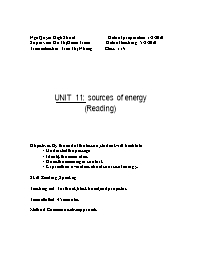Bài soạn môn học Tiếng Anh lớp 11 - Unit 11: Sources of energy (reading)

Objectives: By the end of the lesson, students will be able to:
- Understand the passage
- Identity the main idea.
- Guess the meaning in context.
- Express their own ideas about sources of energy.
Skill: Reading, Speaking
Teaching aid: Textbook, blackboard, and projector.
Time allotted: 45 minutes
Method: Communicative approach.
Bạn đang xem tài liệu "Bài soạn môn học Tiếng Anh lớp 11 - Unit 11: Sources of energy (reading)", để tải tài liệu gốc về máy bạn click vào nút DOWNLOAD ở trên
Ngô Quyền High Shool Date of preparation: 1/2/2010 Supervisor: Hồ Thị Diễm Trâm Date of teaching: 5/2/2010 Trainee teacher: Trần Thị Nhung Class: 11/5 UNIT 11: sources of energy (Reading) Objectives: By the end of the lesson, students will be able to: - Understand the passage - Identity the main idea. - Guess the meaning in context. - Express their own ideas about sources of energy. Skill: Reading, Speaking Teaching aid: Textbook, blackboard, and projector. Time allotted: 45 minutes Method: Communicative approach. PROCEDURE: Content Activity A. Stabilization(1minute) - Greeting B. Check up(3minutes) - Call student to write new words. C. Warm up: (4minutes) Guessing pictures Pictures: Keys: coal, gas, oil, electricity. - Teacher gives pictures and asks student to guess what it is in English. - Call student to say out answers - Check with the class. - Show answers on slide. - Teacher leads to new lesson: Today we learn about sources of energy. D. New lesson: I. Pre Reading.(10minutes) 1. Name pictures (on page 124 in texbook ). Keys: The sources of enery in the pictures are: Wind turbine → wind power, solar panel → solar enery, Dam → water power (hydroelectric power). 2. Pre vocabulary: 1. alternative (adj): changeable 2. reserve (n): sù dù tr÷ 3. to exhaust (v): to run out of, to weaken, to empty: lµm can kiÖt 4. released (adj): be free: th¶, phãng thÝch 5. limited (adj): giíi h¹n, cã h¹n. - Teacher asks student to look at the pictures - Student work in pair to give answer. - Call student to say out answers. - Check with the class. - Teacher gives new words. - Ask students to take note into notebook. - Teacher reads these words modal. - Ask student to repeat the words after teacher. - Call student to read the words again. II. While reading.(18minutes) Task1 (p.126) Fill each blank with a suitable word. Keys: 1. released, 2. alternative, 3.energy, 4.limited, 5.exhausted. Task 2 (p.126) Scan the passage and write down the advantage (s) and disadvantage (s) of each alternative source of energy. Sources of energy Advantage(s) Disadvantage(s) Nuclear power Solar energy Water power Wind power Geothermal heat Task 3:Answer the questions 1.What is our major source of energy? 2.How many sources of energy are mentioned in the text ? 3.Which energy has the most potential ? Keys: 1. Most of our energy comes from fossil fuels. 2. Six sources of energy are mentioned in the text. They are: fossil fuel, nuclear energy, geothermal heat, wind power, water power, and solar energy. 3. Solar energy is the most potential. (plentiful, infinite, clean and safe. III .Post reading(7minutes) Gap filling We need energy to live and work. Our major source of (1)... is oil. Oil is (2)..... kind of fossil fuel. The amount of fossil (3)....... in the world is (4)... Therefore, we must save it, and at the same time, we must find new sources of energy. Geothermal heat and nuclear power are (5)....sources of energy. They can give us electricity. Other alternative (6) are the sun, waves and water. These sources are not only (7) and available but also clean and safe for the (8) People should develop and use them more and more in the future. Keys: 1.energy, 2. one, 3.fuels, 4. limited, 5. alternative, 6.sources, 7.plentiful 8.environment. - Have student read the text in 2 minutes to do the tasks that follow: (task 1,2,3 in textbook). - Ask student to work individually to give answer. - Call student to say out answers. - Check with the class. - Ask student to work in pairs to give answer. - Call student to write answers on the board. - Check with the class. - Teacher shows answers on slide. - Ask student to work in pairs to give answer. - Call student to say out answers. - Check with the class. - Ask student to work in pairs to find the answer. - Call student to say out answers. - Check with the class. E. Homework(1minute) - Learn new words. - Prepare new lesson. - Students write down homework in their notebook. BCDTTSP (Duyệt) GVHDGD (Kí tên) SVTT dạy (Kí tên)
Tài liệu đính kèm:
 giao an.doc
giao an.doc





